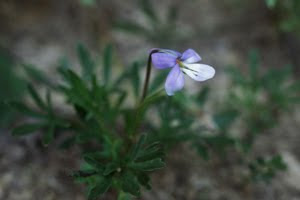+4.jpg)
©Photos by Paul E. Rothrock
Carex emoryi Dewey
Konza Prairie, Riley County, Kansas
Perennial
Height: 16-44 inches
Family: Cyperaceae - Sedge Family
Flowering Period: April, May
Culms: Slender, triangular, usually rough on angles, base reddish-purple, leaves of previous years often persistent.
Leaves: Flat to rolled under from margins, usually longer than culms, 1/8 to 1/4 inch wide; margins rough.
Sheaths: Glabrous; lowest sheaths bladeless, outer surface reddish-brown, inner surface white-translucent.
Ligules: Shorter than width of blade.
Inflorescences: Lowest bract leaf-like, equaling inflorescence, others smaller; spikes unisexual; upper 2-3 spikes staminate, .8 to 2 inches long, more or less erect, stalked; staminate scales egg-shaped, brown with tawny mid-vein, tips rounded; lowest 2-3 spikes pistillate, erect to ascending, 1 to 4 inches long, sessile to short-stalked, bases slender, often with few staminate flowers at tip; pistillate scales 1/12 to 1/7 inch long, about as long as perigynia, ovate to elliptic, pale or reddish-brown, mid-vein tawny, tip tapering to point; perigynia numerous, somewhat flattened, ovate, dull green to straw-colored, 3- to 5-nerved on each side, surface granulated, beak minute.
Fruits: Achenes, lens-shaped, 1-seeded, dull brown; stigmas 2.
Habitat: Margins of streams, ponds, lakes and marshes; ditches, wet meadows; often in standing water; usually on calcareous soils.
Distribution: East 2/3 of Kansas.
Comments: From stout, scaly rhizomes. Named for Major William Helmsley Emory, 1811-1887, who participated in the boundary survey between the U.S. and Mexico.








+2.jpg)
+4.jpg)
+3.jpg)
+2.jpg)
+1.jpg)
+3.jpg)
+2.jpg)
+1.jpg)
2.jpg) From Connecticut Botanical Society
From Connecticut Botanical Society+1.jpg)
+2.jpg)
.jpg)